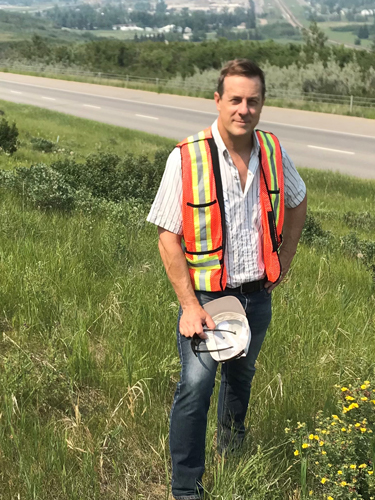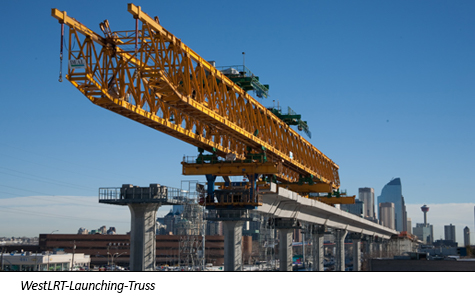 TAC: Tell us about yourself!
TAC: Tell us about yourself!EA: Born and raised in the BC Kootenays, I’ve spent time in almost all provinces and territories (except Nunavut) including a brief stint in Toronto, where I completed undergraduate studies. However, my family life and career have been spent in the Coast and Rocky Mountains of BC and more recently in Alberta, for the past 11 years.
I am a passionate outdoors person, keen on running rivers, climbing mountains, and skiing them.
A fun fact, as some of my TAC colleagues know, is I’ve had the great pleasure to play roots and blues music all across Canada, on stages and in studios. In foreign countries I’ve found that music is a great language to cross barriers.
EA: Currently I’m in the role of manager responsible for the environmental regulatory compliance and sustainability performance of Calgary’s transportation department of over 4,000 staff. My team and I support all capital and operational activities across the full lifecycle of planning, development, decommissioning, maintenance and operation of walking and wheeling infrastructure, bridges, roads, rights-of-way, buses, light rail transit, and associated facilities for our city of 1.3M people.
What I enjoy most about the work is the multi-disciplinary aspect and the collaboration, in that it involves engineering, ecology, energy management, water resources management, and other disciplines. Over a 30-year career to date and mostly in private sector consulting I’ve had the opportunity to gain broad and deep experience to apply to this role. Earlier in my career much of my work in western Canada was focused on natural resources development, and increasingly I began to apply my environmental management training and experience to the development of infrastructure with a more recent focus on transportation.
EA: The Sea-to-Sky Highway Improvement Project, involving a $1.5B upgrade of Highway 99 between West Vancouver and Whistler, was probably the single most satisfying project. My initial role as technical specialist lead for environmental assessment morphed into an oversight role for the procurement and then execution of the project through a Design-Build-Finance-Operate (DBFO) delivery method over several years.
Part of my role was to identify all of the key recreation land uses and develop mitigation strategies and project commitments to minimize their loss or disruption of access, and this in a place with spectacularly high recreation values: world-class sport rock climbs next to the highway, key trailheads and access points, popular provincial parks, scenic viewpoints, etc. The project received recognition from TAC for environmental and community benefits, and it resulted in a safer and superior travel experience (and gateway to adventure) for residents and visitors from around the world.
EA: The Sea to Sky project was my first exposure to TAC as that project had garnered an Environmental Achievement Award in 2008. A few years later, after joining the City of Calgary in the transportation environment role, I began participating in the TAC Environment Council and committees. After a few years of participation, I then stepped forward to serve Executive roles in committees and now (8 years active) I’m transitioning into Chair of the Environment and Climate Change Council.
The practice of environmental management in the specific context of transportation infrastructure development and operations is a relatively specialised field, and it presents an interesting variety of challenges and opportunities. What I really value about TAC is our focus on the development and sharing of beneficial management practices that are informed by practical experience that is gained and applied in all sorts of settings from coast to coast to coast of this country.
EA: Participation in TAC has broadened my perspective on transportation systems across Canada, and it has enabled me to not have to “re-invent the wheel” in my own work. We leverage our member contributions for a collective gain, where the sum is greater than its parts, and as a result Canadians benefit from well-developed and sustainably managed infrastructure. From my perspective that is the best things about being a TAC volunteer. Additionally, being an active member of the volunteer executive has helped me to further develop certain leadership skills.
 TAC: Tell us about a challenge that you would like to help solve.
TAC: Tell us about a challenge that you would like to help solve. EA: Roadways have under-developed potential to provide an array of environmental services and benefits, not the least of which is pollinator habitat. We’ve been increasingly active in pilot projects, exchanging information, and (through pooled funding of TAC members) advancing the art and science of “roadside ecology” to not only achieve operational cost savings where possible but also change the value proposition of doing things differently in our road rights-of-ways for increased environmental and community benefit.
EA: In my experience, having a well-defined, specialist skillset is important but not at the exclusion of being a capable generalist or working effectively in multi-disciplinary teams. I think it’s important to be curious and creative, to make connections between different areas of study and practice, and to make good use of the universe of data that is now available like never before.